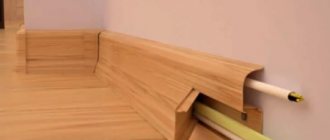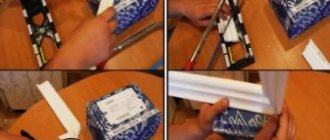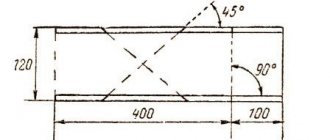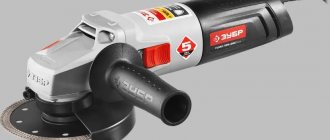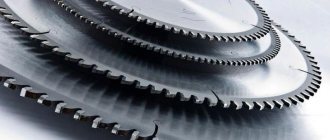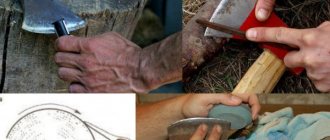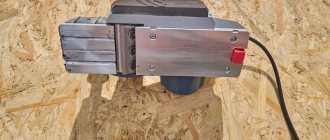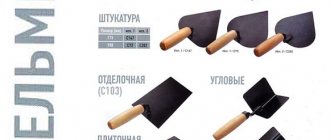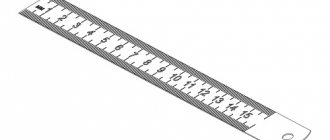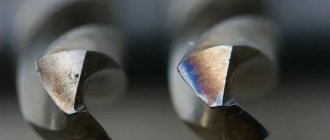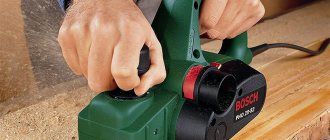What is a protractor?
A protractor is an object with which each of us can not only measure angles, but also construct them. Outwardly, it resembles a semicircular ruler with a scale and divisions. Below, on a flat surface, there is a straight ruler familiar to us for measuring segments. At the top there is a semicircle with a double scale for measurements. In each direction, the scale is distributed along the protractor from 0 to 180 degrees.
Measuring angles
How to measure angles with a protractor? Let's show it clearly in the illustrations.
Method 1
With this method, the size of the angle is determined using an external scale. The maximum angle that can be measured using this method is 110 degrees.
Method 2
The second method is applicable for measuring obtuse angles from 90° to 180°.
A second internal scale is used for measurement.
Method 3
The third method also works in the measurement range from 15° to 180°.
The size of the angle is determined by the second internal scale.
Method 4
The fourth method is a modification of the third. Available measurement range from 0° to 75°.
The size of the angle is determined by the third internal scale.
Method 5
The fifth method is a modified method No. 2 only for acute angles from 15° to 90°.
This method uses a second internal scale.
Method 6
The sixth method allows you to measure angles from 90° to 165°.
This method uses the first internal dimensional scale.
Terms of use
At school they explain what a protractor is in math lessons. This is where measurements are needed.
In order to find out what one degree is equal to, we need to divide the circle into 360 equal parts. One of these parts will be equal to 1 degree. The size of the circle will not affect the degree in any way! This is easy to check.
Let's draw two circles of different diameters and divide each into 360 equal parts. Then we will superimpose the smaller circle on the larger one and see that the lines coincide.
Measuring the angle
A protractor helps construct and measure an angle. A degree is a common unit used to measure angles. There are several types of angles:
- Spicy. This is called an angle of up to 90 degrees.
- A right angle is an angle equal to 90 degrees.
- The obtuse angle varies from 90 to 180 degrees.
- A straight angle is a straight line or 180 degrees.
- A full angle looks like a circle and is 360 degrees.
It's not difficult to figure out how to measure an angle. In order to find out what the size of the angle is, we need to install the protractor so that its center is located at the apex of the angle, and the straight side coincides with one of its sides. The scale will tell us the number of degrees of a given angle. In this simple way we can find out what is around the corner in front of us.
To construct an angle with a given degree, you should attach the straight part of the protractor to the line, and its center to the beginning of the line. Subsequently, this point will be the vertex of the angle. Then we find the given number on the scale and put a dot. Now the protractor can be removed and connected with a segment from the beginning of the line (vertex of the angle) to the marked point.
School stationery produced by different companies differs in material, color, and size. So: for those whose protractor turns out to be longer than the length of the angle, and it is not possible to determine its value, the side of the angle must be extended using a straight ruler.
Measuring angles. Protractor
In this lesson we will get acquainted with a device for measuring angles - a protractor. Let's learn how to measure and construct angles using a protractor.
Let's touch on history to find out how the protractor
.
The concept of “degrees” and the appearance of the first instruments for measuring angles are associated with the development of civilization in ancient Babylon. Although the word degree
is of Latin origin (
degree
– from Latin
gradus
– “step, step”). It is believed that the creation of the protractor was associated with the creation of the first calendar.
Ancient Babylonian mathematicians and astronomers divided a complete revolution (circle) into as many parts as there are days in the year. They thought there were 360 days in a year. Therefore, they divided the circle indicating the year into 360 equal parts. This image was very convenient. It was possible to mark each passing day and see how many days were left until the end of the year. Each part was given a name - degree
.
Each degree
is divided into 60
minutes
, and
a minute
is divided into 60
seconds
. The degree measure has survived to this day.
So, a protractor
.
Protractor
consists of
a ruler
(straight scale) and
a semicircle
(goniometric scale).
The center
of this semicircle is marked on the protractor either with a stroke or a hole. The protractor scale lines divide the semicircle into 180 parts. In some models - for 360 shares - these are round protractors.
If we draw rays from the center of this semicircle through each stroke, we get 180 angles. Each of which is equal to a fraction of a turned angle.
Definition
Such angles are usually called degrees.
.
Degrees are denoted by this sign: °.
Each protractor scale division is equal to 1°. In addition to 1° divisions on the protractor scale, there are also 5° and 10° divisions.
Now let's figure out how to measure an angle using a protractor. Remember the angle measurement algorithm
:
1) Align the vertex of the angle with the center of the protractor
.
2) Position the protractor so that one of the sides of the angle passes through the origin on the protractor scale; 0 – start of counting
.
3) Find a line on the scale through which the second side of the angle will pass;
(note, we use the same scale to determine the degree measure of the angle where the zero degree is located)
.
4) We look at which stroke the second side passes through and what degree corresponds to this stroke
.
On our slide, angle AOB is 50°. They write like this:
The rotated angle is 180°. Since you and I found out that a right angle is equal to half of a straight angle, then it is equal to
Right angle
equals 90°.
Since equal angles are completely combined when superimposed, equal angles have equal degrees
.
Therefore, a larger angle
has a larger degree measure,
a smaller angle
has a smaller degree measure.
The protractor is used not only for measuring angles, but also for constructing them.
Let's remember the algorithm for constructing angles
.
We will explore the algorithm using a specific example
: construct an angle MKN equal to 110°.
1. Let's mark an arbitrary point and designate it with the letter K
.
2. Let's draw a ray with the beginning at point A and mark an arbitrary point M on it. We get the ray KM
.
3. Let's place the protractor so that its center coincides with point K, and the beam KM passes through the origin on the scale
.
4. On the same scale of the protractor we will find a stroke that corresponds to 110°.
N on the drawing opposite the stroke marked 110°
.
5. Let's draw a ray K N . The angle MK N
is the required one
.
6. Don’t forget to write down MK N
= 110°
.
The same angle can be constructed on the other side of the KM beam.
Everywhere there are angles of any kind: straight, acute, obtuse, there are adjacent ones, there are unfolded ones, there are many of them, you can’t count them all.
Definition
If the angle is less than 90°, then it is called an acute angle
.
If an angle is greater than 90° but less than 180°, then it is called an obtuse angle.
.
The screen shows the angle AOS - acute
and angle MKN is
obtuse
.
The degree measure of the angle AOS is 30°, i.e. less than 90°, therefore it is sharp
.
The degree measure of the angle MKN is equal to 120°, i.e. greater than 90° but less than 180°, therefore it is obtuse
.
Results
So, today in class we got acquainted with a device for measuring angles - a protractor. We learned to use it to measure and construct angles.
Schoolboy set
It is no wonder that junior students are not familiar with the protractor. When using it, a certain knowledge base must be laid down. To fully work with it in class, children study a number of related subjects. Before learning what a protractor is, schoolchildren must master a straight ruler, draw straight lines, learn addition and subtraction, master a compass, know geometric figures, and so on. This entire process takes time, and it is only after graduating from primary school that a student can add a protractor to their toolbox.
Students are now offered a huge selection of school stationery. The protractor is no exception. Manufacturers try to satisfy the most demanding needs of customers. Tools are made in various colors. Children always like bright colors. Sometimes even in the same class you cannot find identical protractors, which makes it easier to find them if they are lost. Everyone chooses shapes and sizes to their own taste.
Most of these products are made of plastic, and this significantly reduces its cost. But there are wooden and even iron protractors. As practice shows, metal ones, although opaque, are more practical in the sense that the scale is not erased, and this allows it to be used in action for much longer, accurately determining angles.
The protractor is not as popular among schoolchildren as the ruler, but it accompanies students right up to the final exam. Some of the school's graduates choose specialties that involve measuring and constructing angles, designing buildings and structures, and working with drawings. Due to their professions, they constantly have to deal with protractors and its derivatives. But even former classmates of current engineers, sometimes even with the deepest humanitarian bias, can easily remember their skills in handling this subject and determine the number of degrees at any angle.
Goniometers
What is a ruler? concept, length, measurement example. types of rulers and their names
First, a little information about tools for measuring angles, so that it is clearer what makes this particular inclinometer stand out from the whole mass. Or you can immediately.
In any engineering and craft business, measuring and constructing angles is one of the most important operations. Even to assemble a simple box you need to adjust 90°, not to mention more complex structures. Not surprisingly, there are a ton of different tools for these measurements. One of the most ancient and famous is the protractor. Everyone has known him firsthand since their school years.
But the protractor itself is more of a drawing tool. They can still measure and mark angles on the material, but they will not be able to measure, for example, the internal angle of slopes themselves.
A simple and well-known carpentry and plumbing tool for measuring and constructing angles is a small tool.
In its standard version, the malka is only a tool for transferring angles - an angle is fixed using a reference angle or a protractor, which can then be drawn, compared, measured, etc. For this reason, it is usually used in conjunction with a protractor. More advanced small fish may have their own scale for marking and determining the angle, and with the modern development of electronics, even electronic ones have appeared.
The historical version of the simplest protractor is two rulers united by a common axis. This design is still used in most electronic and mechanical inclinometers today. There are other, more complex designs. Naturally, everyone has their own characteristics, advantages and disadvantages. For example, the one on the far right in the photo is not capable of measuring internal angles (in case you suddenly wanted to buy a similar one).
The most important indicator of any measuring instrument is accuracy, and inclinometers are no exception. Obviously, inclinometers equipped with a vernier or electronics will have the greatest accuracy. But the design itself is not a verdict; it all depends on the manufacturer. If you need benchmark accuracy and quality, look towards leaders like Mitutoyo, Starrett. The main thing is not to be scared when you find out the price.
From available means, the simplest protractor can be made by taking two blades (or two pieces) of a hacksaw for metal and connecting them with a bolt through the mounting hole.
All of the above devices did not suit me either in functionality or price, until I came across a plastic kwb protractor. The international valid patent for it (US 4766675 A from 1988) belongs to the Taiwanese company CCKL. Creator International
.
All of these options for this goniometer are completely identical in design and have fairly positive reviews. As for the quality, I can’t say, I haven’t had the opportunity to hold all of them in my hands. It may be sold under other brands as well. In any case, I voiced the analogues for information, so that you can choose any of the ones most available to you.
My goniometer in the review belongs to the German marketing brand kwb
. This company sells very good hand tools and accessories, and has a very decent reputation. Some of the products are made in Germany, some in China, some elsewhere.
By marketing brand I mean companies that do not develop or produce anything (or almost anything), but only sell under their own name, ordering products from OEM manufacturers. There are a lot of such brands now, including Russian Zubrs, Skrabs, Stayers and others. This in itself is normal, but it is obvious that the companies that actually produce their products deserve more trust.
